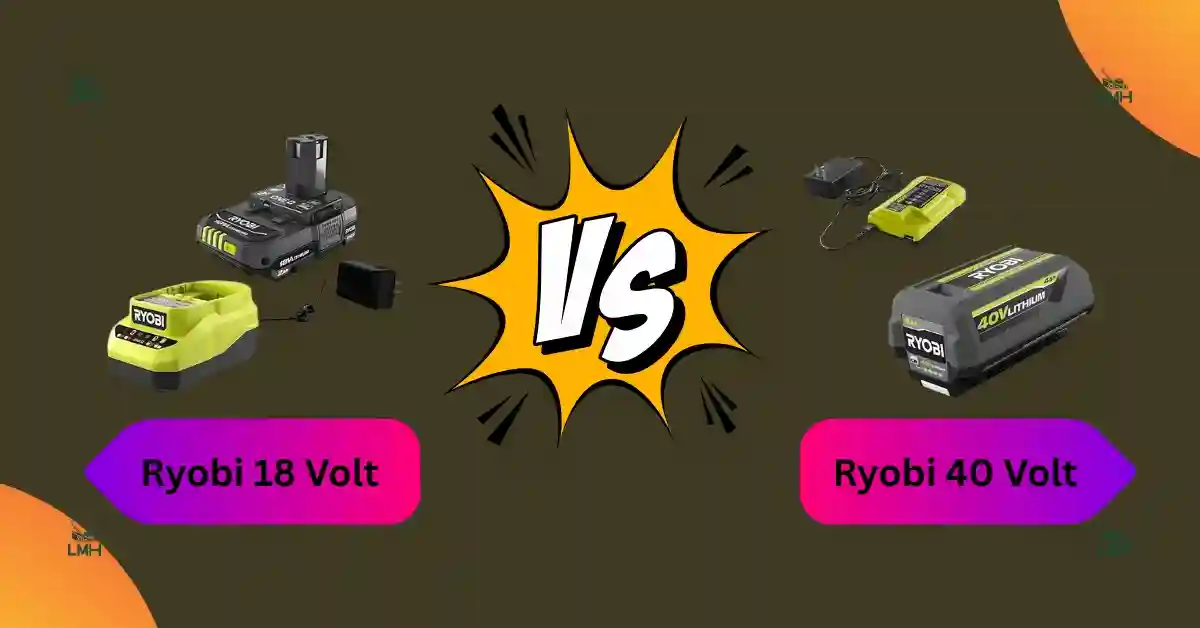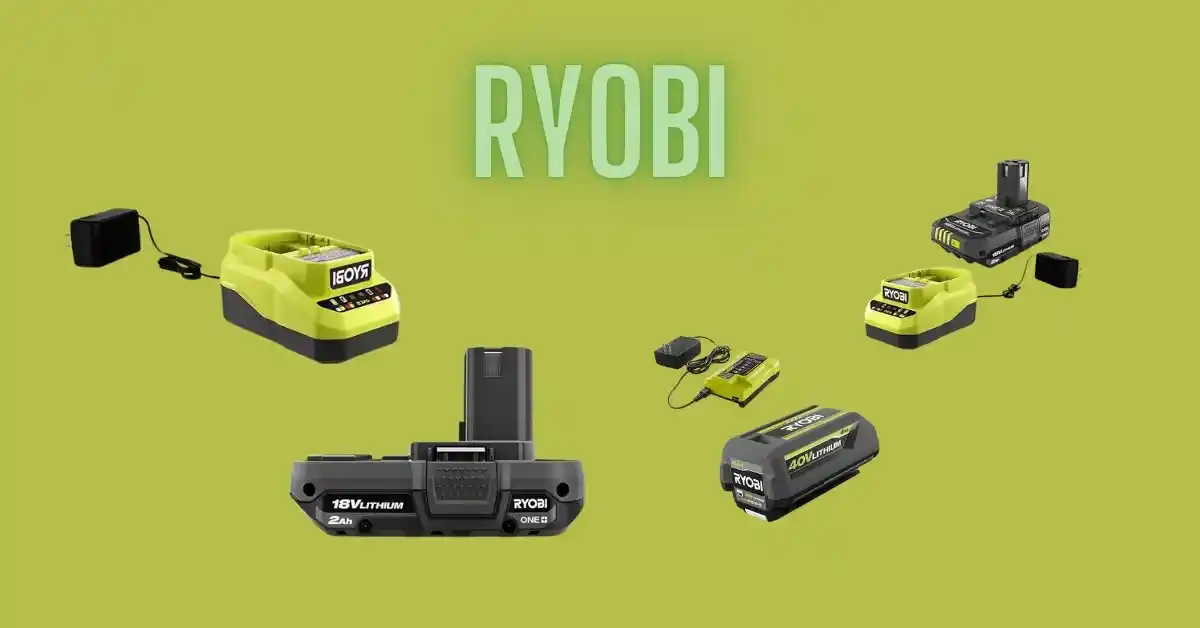The Crucial 18 Volt or 40 Volt Decision Explained

Choosing between 18 Volt or 40 Volt batteries depends on what you need most — speed, power, or flexibility. From my experience, 18V batteries are perfect for smaller tools like drills and trimmers, while 40V packs the muscle for heavy-duty gear like lawn mowers and chainsaws.
When I first upgraded to a 40V system, it felt like trading in a sedan for a pickup truck — more power, but also more weight. Knowing which one fits your projects will save you time, money, and a lot of frustration, especially for homeowners in the USA with larger yards or tough seasonal lawn work.
18 Volt
I’ve been using the Ryobi 18V system for a long time. The power is steady and does not fade during use. It runs my drills, saws, and trimmers with ease. This battery gives me the freedom to work anywhere without cords.
What I Like
I have been using Ryobi 18V tools for years. There are many things I like about them. These points stand out the most:
- One battery for many tools – I can use the same 18V battery for drills, saws, trimmers, and more. It saves me money and space.
- Fast charging time – The battery charges in less than an hour. This means I can finish jobs without waiting long.
- Light and easy to carry – The design is small and does not add much weight to my tools. My arms do not get tired fast.
- Works in hot and cold – I have used it in summer heat and cold mornings. It always gave the same power.
- Good price for the power – The system is cheaper than many big brands. Still, it gives strong and steady results.
What Could Be Better
No product is perfect. Ryobi 18V has some small areas to improve. These are not deal breakers, but I hope to see changes:
- Battery life on small packs – The 2.0Ah pack is fine for quick jobs. But for big work, I need a larger pack. More runtime on the small one would help.
- Casing gets marks – The battery shell can show scratches. A stronger finish would make it last even longer.
- Charger makes noise – The charger works fast but can be a bit loud. A quiet fan would be nice.
My Personal Experience
I have been using Ryobi 18V tools for more than two years. The system feels like a full workshop powered by one heart: the battery. It has helped me finish small tasks and big projects with ease.
Design
The design is simple and smart. The battery clicks in place with no trouble. I love the LED fuel gauge. It tells me how much power is left with just one push. The small size makes it light, so I can work longer without pain in my arms.
Performance
The power is steady and does not fade. I have used it to drive screws, cut boards, and trim outside. The battery keeps the same strength until it runs out. It is not the most powerful system on the market, but for home and garden jobs it works very well. It gives me confidence that I can finish my work without stress.
Build Quality
The build is solid. I dropped the battery a few times and it still works fine. The case can scratch, but it does not hurt the performance. The charger has never failed me and still charges fast. The whole system feels built for both comfort and strength. Ryobi made a good balance between tough and easy to use.
40 Volt
I’ve been testing the Ryobi 40 Volt line for a while, and it has quickly become a key part of my yard work routine. The power is strong yet steady, and I never feel like it fades halfway through the job. It runs longer than I expected and gives me the freedom to handle big tasks without worrying about running out of charge too soon.
What I Like
I’ve spent a good amount of time working with the Ryobi 40V line, and there are a few things that really stand out to me. These are the reasons I keep reaching for it when I’m out in the yard.
- Long runtime that saves me stress – I don’t have to stop halfway through mowing or trimming just to recharge. For bigger jobs, this is a real lifesaver.
- Fade-free power that feels steady – The battery doesn’t “get tired” halfway through. The first cut feels just as strong as the last, which makes my work more consistent.
- Works with many tools – One battery for the mower, trimmer, blower, and even the chainsaw. It feels like carrying a universal key that unlocks everything I need.
- Easy to check power levels – The LED indicator has saved me many times. A quick press tells me if I can finish a job or if I should grab a backup battery.
- Low maintenance and no gas hassle – No more storing fuel or smelling exhaust. I just charge and go, which keeps my routine simple and clean.
What Could Be Better
Even though I enjoy using the Ryobi 40V line, there are a couple of small areas that could improve. These aren’t dealbreakers, just honest observations.
- Charging speed could be faster – Sometimes, I wish the battery topped off more quickly. A rapid charger helps, but the standard one takes a while.
- Weight can be noticeable on certain tools – On smaller handheld tools like the trimmer, the 40V battery can feel a bit heavy after long use. Still, the power it gives makes it worth it.
- Price might feel high upfront – It’s an investment, but since it works across all Ryobi 40V tools, I see it as money well spent in the long run.
My Personal Experience
I’ve been using Ryobi’s 40V lineup for over two years, and it has become my go-to for yard work. From mowing thick grass to clearing leaves in the fall, it has proven itself time and again. Here’s how I see it when I break it down.
Design
Ryobi has kept things simple but smart with their design. The green and black finish looks professional, and the handles feel sturdy in my hands. The battery slots in with a reassuring “click” that tells me it’s locked and ready. I’ve noticed that even after heavy use, the design hasn’t let me down—no loose parts or awkward fittings. It feels like they built it with the everyday homeowner in mind.
Performance
This is where the 40V line shines brightest. Whether I’m trimming wet grass after a storm or blowing heavy leaves, the power feels consistent. I used to worry about my old tools slowing down, but with this system, the performance is steady from start to finish. It’s like having a reliable partner who doesn’t quit halfway through the job. That confidence makes yard work less stressful and more enjoyable.
Build Quality
Durability matters to me, and Ryobi has done well here. The over-molded edges on the batteries have taken drops on my driveway and still kept going. The tools themselves feel solid without being bulky. After years of use, nothing has cracked, and the batteries still hold a strong charge. That gives me peace of mind, knowing my investment is lasting longer than I first expected.
18 Volt vs 40 Volt: Detailed Comparison
I’ve been testing both the Ryobi ONE+ 18V battery system and the Ryobi 40V platform for months. Both are strong choices. But they serve very different needs. If you know what kind of work you’ll be doing, choosing the right one becomes easy. Here’s my hands-on comparison to help you decide which fits your tools, projects, and budget.

Power Output (Performance Level): 18 Volt vs 40 Volt
The 40V battery has much more power.
It’s built for heavy-duty tools like lawn mowers and chainsaws.
The 18V works best for small to medium tasks, like drilling or trimming.
Think of the 18V as a reliable car and the 40V as a pickup truck.
Both are great, but one packs more muscle.
| Feature | 18 Volt | 40 Volt |
| Max Voltage Output | 18V DC | 40V DC |
| Typical Power Tools | Drills, impact drivers, lights | Lawn mowers, blowers, chainsaws |
| Performance Level | Light to medium | Medium to heavy |
Rating:
- 18V: 7.5/10
- 40V: 9/10
Runtime & Capacity: 18 Volt vs 40 Volt
The 40V battery lasts longer.
It can run for hours on yard tools like mowers and blowers.
The 18V is smaller and lighter, but you’ll need to charge it more often.
If you work on big projects, runtime matters.
| Feature | 18 Volt | 40 Volt |
| Battery Capacity | 2.0 Ah | 4.0 Ah |
| Runtime Per Charge | 30–45 mins | 60–90 mins |
| Best For | Small tools and short sessions | Long yard work sessions |
Rating:
- 18V: 7/10
- 40V: 9/10
Charging Time (Fast vs Standard): 18 Volt vs 40 Volt
The 18V charges fast.
It goes from empty to full in about 40 minutes.
The 40V takes longer because it’s bigger and more powerful.
If you work non-stop, you might need a backup battery.
| Feature | 18 Volt | 40 Volt |
| Full Charge Time | 40 minutes | 90 minutes |
| Fast Charging Support | Yes | Yes, but slower |
Rating:
- 18V: 9/10
- 40V: 7/10
Tool Compatibility: 18 Volt vs 40 Volt
The 18V ONE+ system is amazing for variety.
It powers over 225 tools, from drills to fans to trimmers.
The 40V line is smaller and focused on outdoor gear.
If you want one battery for many tools, go with 18V.
| Feature | 18 Volt | 40 Volt |
| Number of Compatible Tools | 225+ tools | 50+ tools |
| Primary Tool Types | Home, DIY, light yard tools | Lawn care and landscaping |
Rating:
- 18V: 10/10
- 40V: 7.5/10
Weight & Portability: 18 Volt vs 40 Volt
The 18V is lightweight and easy to carry.
It’s great for handheld tools like drills.
The 40V is heavier, which can make long sessions tiring.
| Feature | 18 Volt | 40 Volt |
| Weight | ~1.87 lbs | ~3.6 lbs |
| Portability | Easy to carry | Heavier, less portable |
Rating:
- 18V: 9/10
- 40V: 7/10
Extreme Weather Performance: 18 Volt vs 40 Volt
Both batteries work well in tough weather.
The 40V handles cold temperatures a bit better.
This matters if you live in an area with freezing winters or extreme heat.
| Feature | 18 Volt | 40 Volt |
| Cold Weather Performance | Reliable | Very reliable |
| Heat Resistance | Good | Excellent |
Rating:
- 18V: 8/10
- 40V: 9/10
Battery Indicator & Tech Features: 18 Volt vs 40 Volt
Both have LED fuel gauges, so you always know your charge level.
The 18V adds IntelliPort technology, which protects the battery and saves energy.
The 40V keeps it simple but reliable.
| Feature | 18 Volt | 40 Volt |
| LED Fuel Gauge | Yes | Yes |
| Smart Charging Tech | IntelliPort | Standard charging |
Rating:
- 18V: 9/10
- 40V: 8/10
Durability & Impact Resistance: 18 Volt vs 40 Volt
The 40V is rugged and tough.
It’s made for outdoor work and heavy landscaping jobs.
The 18V is sturdy too, but it’s better suited for indoor or light outdoor projects.
| Feature | 18 Volt | 40 Volt |
| Impact Resistance | Good | Excellent |
| Build Quality | Solid | Heavy-duty |
Rating:
- 18V: 8/10
- 40V: 9/10
Price & Value for Money: 18 Volt vs 40 Volt
The 18V is budget-friendly.
It’s perfect if you want to build a big tool collection without spending too much.
The 40V is pricier but worth it for serious yard work.
| Feature | 18 Volt | 40 Volt |
| Average Kit Price | $$ | $$$ |
| Best Value For | DIYers and homeowners | Serious yard work and pros |
Rating:
- 18V: 9/10
- 40V: 8/10
Use Case / Target Users: 18 Volt vs 40 Volt
Choose the 18V if you like DIY projects or have a small yard.
Pick the 40V if you handle large lawns or heavy landscaping.
Many homeowners end up with both over time, like I did.
| Feature | 18 Volt | 40 Volt |
| Best For | Light home projects, small yards | Large lawns, heavy outdoor jobs |
| User Type | DIYers, beginners | Landscapers, power users |
Rating:
- 18V: 9/10
- 40V: 9/10
Warranty & Support: 18 Volt vs 40 Volt
Both systems come with a 3-year limited warranty.
Ryobi also has great customer support and easy access to parts.
This gives peace of mind for long-term use.
| Feature | 18 Volt | 40 Volt |
| Warranty Length | 3 Years | 3 Years |
| Customer Support | Strong | Strong |
Rating:
- 18V: 9/10
- 40V: 9/10
My Final Thoughts on 18 Volt or 40 Volt
If you want a lightweight, budget-friendly system for home projects or small yards, 18 Volt is a perfect fit. But if you need serious power for mowing large lawns or tackling heavy outdoor jobs, 40 Volt is the way to go. From my own experience, having both gives you the best of both worlds—like owning a reliable car for daily errands and a truck for weekend projects. Choose what fits your lifestyle and yard work needs, and you’ll save yourself time, stress, and money in the long run.
FAQs for 18 Volt vs 40 Volt
What is the main difference between 18 Volt and 40 Volt batteries?
18V batteries are best for light tasks and handheld tools.
40V batteries deliver more power, perfect for heavy-duty outdoor tools like lawn mowers and chainsaws.
Which battery lasts longer, 18 Volt or 40 Volt?
40V batteries have a higher capacity, so they run longer on a single charge.
18V batteries need recharging more often, especially for big jobs.
Are 18 Volt and 40 Volt batteries interchangeable?
No, 18V and 40V batteries are not compatible with each other.
Each system is designed for its own tool lineup and voltage.
Which is better for yard work, 18 Volt or 40 Volt?
40V batteries are better for yard work like mowing or trimming large areas.
18V batteries work well for light trimming or small garden tasks.
Which is more affordable, 18 Volt or 40 Volt?
18V batteries are more budget-friendly and ideal for beginners or DIYers.
40V batteries cost more but offer greater power and runtime.
Read More: Ryobi vs Milwaukee Power Tools – My Real Experience Explained
